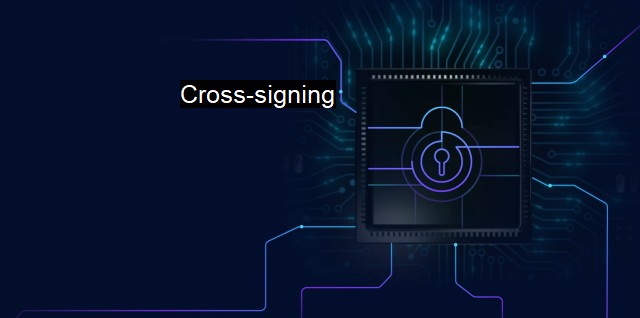What is Cross-signing?
The Significance of Cross-Signing in Cybersecurity and Antivirus: Establishing Trust between Digital Entities and End-Users for Confidential Information
Cross-signing is a concept that circles around the dimensions of cybersecurity and antivirus landscapes. It has rapidly evolved into an essential component that bolsters system security and enhances both trust and legitimacy in the digital realm. cross-signing is a contract authenticated by multiple entities which is intended to maximize trustworthiness. Powers invested into cross-signing come from digital certificates,-root certificates, and Certificate Authorities (CAs), thus adding impeccable dimensions to the idea of global cybersecurity.A typical digital certificate contains a public key intended for the subject along with other details about the subject. Each certificate also holds information about the issuer or the Certificate Authority (CA). When a CA issues a certificate, it signs the certificate with its private key, ensuring the authenticity of the certificate. In a hierarchical model, there can be multiple layers of CAs, creating trust chains from intermediate to root CAs. This relationship allows any party interacting with the certificate to trust its authenticity based on their trust in the issuer.
Cross-signing is an evolution that takes this very idea one step further. Instead of having certificates validated by a single CA, the certificate is now confirmed by multiple authenticating sources or other CAs. Here is where cross-signing steps in with all its practicality, offering a powerful solution to potential security risks. When a certificate is validated by several CAs, the fabric of trust is woven tighter, the risk of unauthorized intrusions is minimized, and the user is exonerated from resorting to heavy-duty ways of ensuring safety.
This doesn't only increase the trustworthiness but also adds functional value in cybersecurity landscapes. A vital advantage being that with cross-signing, certificate chains can be traced back to numerous other recognized authorities or root certificates. Here's why this becomes a pivotal factor in cybersecurity. It adds an effective, affable layer of redundancy to the security system. If one Certificate Authority's security comes into question or gets compromised, the system won't crumble. The cross-signed certificate still maintains its legitimacy, with its association with the remaining uncompromised CAs.
Cross-signing is also commonly employed for compatibility reasons. If certain devices or browsers do not have a specific root certificate installed, having a cross-signed certificate would mean there is at least one route of trust to an installed and recoginzed root certificate, eventually ensuring seamless operations.
In antivirus navigation, the verdict of cross-signing holds a valuable place too. Interestingly, cross-signing offers appreciable antivirus benefits, like confirming the authenticity of system updates, guarding against rogue softwares masquerading under pretentious banners and ensuring the originality of the data received. As such, antivirus software significantly relies on these certificates to differentiate malicious applications or content from trusted ones.
To sum it up, cross-signing works as a double or multiple level of authentication that strengthens the reliability and authenticity of a system while reinforcing the concept of trust in cybersecurity. By integrating redundancy, its value in minimizing and managing risks. In this present era where cyber threats are becoming prevalent and increasingly sophisticated, deploying cross-signing methodologies appears more of a necessity. It's not just about the technical effervescence it brings onboard, but the holistic assurance of trust, safety, and comfort. This is the significant force that keeps the wheels of cybersecurity and antivirus gallantly rolling without frequent halts, hitches, or anxieties, effectively turning cross-signing into a central pillar in cybersecurity architecture.

Cross-signing FAQs
What is cross-signing in cybersecurity and antivirus?
Cross-signing in cybersecurity and antivirus is a process of digitally signing certificates with multiple certification authorities (CAs) to add an extra layer of security. This process helps to establish trust relationships between various entities in the digital world.How does cross-signing enhance cybersecurity and antivirus protection?
Cross-signing enhances cybersecurity and antivirus protection by enabling users to verify the authenticity of digital certificates that they receive from other entities. This process reduces the risk of spoofing attacks and ensures that users can trust the digital certificates they receive.What are the benefits of using cross-signed certificates for cybersecurity and antivirus?
The benefits of using cross-signed certificates for cybersecurity and antivirus include increased trust and security, better protection against phishing and other types of attacks, and the ability to establish secure connections with other entities in the digital world.What are the potential risks and challenges associated with cross-signing in cybersecurity and antivirus?
The potential risks and challenges associated with cross-signing in cybersecurity and antivirus include the risk of compromised or fraudulent certificates, the cost and complexity of managing multiple certification authorities, and the need to carefully manage trust relationships and verify the authenticity of digital certificates.Related Topics
Digital Certificates Code Signing Two-Factor Authentication (2FA) Vulnerability Scanning Network Segmentation
| | A | | | B | | | C | | | D | | | E | | | F | | | G | | | H | | | I | | | J | | | K | | | L | | | M | |
| | N | | | O | | | P | | | Q | | | R | | | S | | | T | | | U | | | V | | | W | | | X | | | Y | | | Z | |
| | 1 | | | 2 | | | 3 | | | 4 | | | 7 | | | 8 | | |||||||